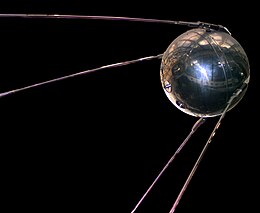
Back Spoetnik 1 AF Sputnik 1 ALS ስፐትኒክ AM Sputnik 1 AN سبوتنك 1 Arabic Sputnik 1 AST Sputnik-1 AZ Спутнік-1 BE Спутник-1 Bulgarian স্পুটনিক ১ Bengali/Bangla
 Replica of Sputnik 1 | |
| Names | Спутник-1 |
|---|---|
| Mission type | Technology demonstration |
| Operator | OKB-1 |
| Harvard designation | 1957 Alpha 2 |
| COSPAR ID | 1957-001B |
| SATCAT no. | 00002 |
| Mission duration | 21 days |
| Orbits completed | 1440 |
| Spacecraft properties | |
| Manufacturer | OKB-1 Ministry of Radiotechnical Industry |
| Launch mass | 83.6 kg (184 lb) |
| Dimensions | 58 cm (23 in) diameter |
| Power | 1 watt |
| Start of mission | |
| Launch date | 4 October 1957, 19:28:34 UTC |
| Rocket | Sputnik 8K71PS[1] |
| Launch site | Baikonur 1/5[1] |
| End of mission | |
| Disposal | Orbital decay |
| Last contact | 26 October 1957 |
| Decay date | 4 January 1958[1] |
| Orbital parameters | |
| Reference system | Geocentric |
| Regime | Low Earth |
| Semi-major axis | 6,955 km (4,322 mi) |
| Eccentricity | 0.05201 |
| Perigee | 215 km (134 mi) |
| Apogee | 939 km (583 mi) |
| Inclination | 65.1° |
| Period | 96.2 minutes |
| Epoch | 4 October 1957, 15:12 UTC |
| Instruments | |
| Radio transmitter (20.005 MHz - 40.002 MHz) | |
Sputnik 1 was the first artificial satellite to go around the Earth.[2][3] It was made by the Soviet Union.[2] It was launched on 4 October 1957 at Baikonur Cosmodrome.[2] It orbited (went around) the Earth for three months.[2] It carried a radio transmitter. It did 1,440 orbits of the Earth during this time. It went down into Earth's atmosphere on 4 January 1958 and burned up.[2]
The United States was very surprised when the Soviet Union sent Sputnik 1 into space. It did not want to fall behind. So, it began spending more money on science and education.[4] This was when the Space Race between the Soviet Union and the United States began. The competition helped the US and Russia fuel the United States’ space exploration endeavors
- ↑ 1.0 1.1 1.2 Wade, Mark. "Sputnik 1". Encyclopedia Astronautica. Archived from the original on 27 December 2016. Retrieved 8 January 2017.
- ↑ 2.0 2.1 2.2 2.3 2.4 "Sputnik 1". NASA NSSDC. Archived from the original on 2011-10-19. Retrieved 2011-12-24.
- ↑ Latifiyan, Pouya; Mazlumi, Farhad; HabibNejad, Saeed (2024). "1". Satellite Internet in the Aviation Industry. Aviation Electronics and Telecommunications Engineering Department (1st ed.). Tehran, Iran: Civil Aviation Technology College. doi:10.13140/RG.2.2.25125.92640.
- ↑ Calmes, Jackie (2010-12-06). "Obama Calls for New 'Sputnik Moment'". The New York Times. Retrieved 2011-12-24.